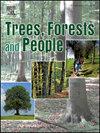南非南潘斯堡森林结构和生物量沿气候梯度的驱动因素
IF 2.9
Q1 FORESTRY
引用次数: 0
摘要
森林结构在全球农村地区提供不同的生态系统服务方面发挥着关键作用。在南部非洲的森林和林地中,缺乏关于主要结构、其非生物和生物驱动因素以及林分特征如何受到气候变化影响的定量信息。在本研究中,我们在具有代表性的森林和沿强气候梯度发生的林地的成熟发育阶段建立永久性研究样地。研究了立地有效土壤水分和森林类型对相关树木和结构森林变量的影响。我们发现,除了树木密度和多茎树比例外,立地有效土壤水分对所有变量都有显著的正影响。在影响立地有效土壤水分的因素中,气候的影响大于地形湿度指数和土壤有效水分容量。研究的变量还受到不同森林和林地类型的强烈影响,这可能是由于不同的物种组成、生存策略和火灾适应。结构林变量对AGB有积极影响,特别是在有足够空间形成多个冠层的较高林分。考虑到气候变化导致南部非洲土壤水分减少以及物种和生物群落的持续变化,我们的研究结果表明,在未来,大多数研究的森林变量及其相关的生态系统功能和服务可能会在南潘斯堡地区减少。这项研究的结果可以用作景观水平建模的输入数据,也可以用于制定地方管理政策。本文章由计算机程序翻译,如有差异,请以英文原文为准。
Drivers of forest structure and biomass along a climatic gradient in the Soutpansberg, South Africa
Forest structure plays a key role for providing different ecosystem services in rural regions worldwide. In forests and woodlands of southern Africa, there is a lack of quantitative information on prevailing structures, their abiotic and biotic drivers, as well as how stand characteristics will be affected by climate change. In this study, we established permanent research plots in mature developing stages of representative forests and woodlands occurring along a strong climatic gradient. Effects of site-available soil water and forest type were investigated for relevant dendrometric, as well as structural forest variables. We found site-available soil water having a significantly positive effect on all variables, apart from tree density and the ratio of multi-stem trees. Among the factors influencing site-available soil water, climate had a higher impact than topographical wetness index and soil available water capacity. Studied variables were also strongly influenced by the different forest and woodland types emerging, probably due to different species compositions, survival strategies and fire adaptations. Structural forest variables were revealed to have a positive effect on AGB especially in taller stands having enough space to form multiple canopy layers. In light of climate change with less soil water available and a related ongoing species and biome shift in southern Africa, our findings indicate that in the future, most of the studied forest variables, their related ecosystem functions and services are likely to decrease in the Soutpansberg region. The results of this study could be of use as input data for landscape level modelling, as well as for creating local management policies.
求助全文
通过发布文献求助,成功后即可免费获取论文全文。
去求助
来源期刊

Trees, Forests and People
Economics, Econometrics and Finance-Economics, Econometrics and Finance (miscellaneous)
CiteScore
4.30
自引率
7.40%
发文量
172
审稿时长
56 days
 求助内容:
求助内容: 应助结果提醒方式:
应助结果提醒方式:


